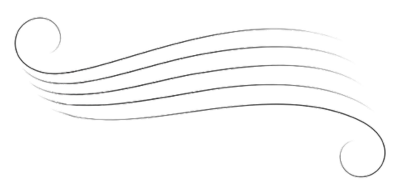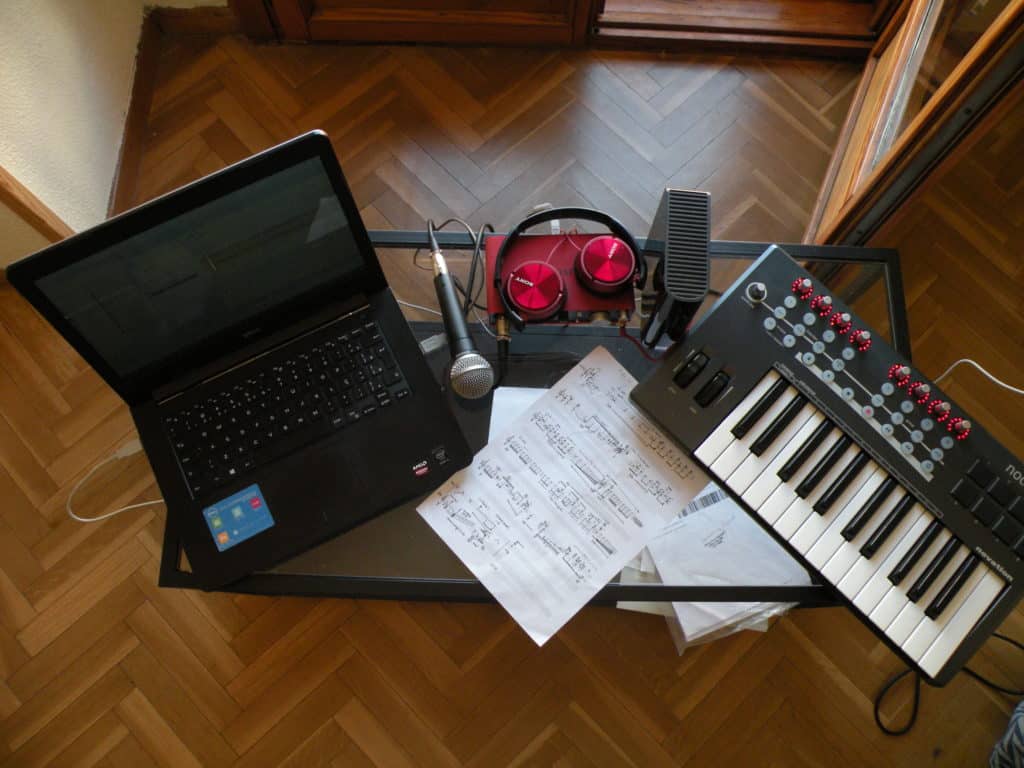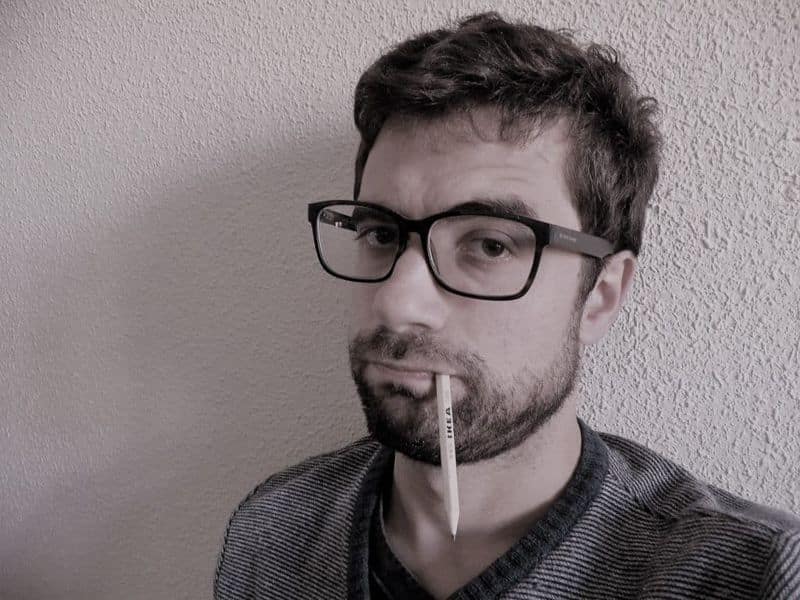What is music made with?
(post from the series My Way of Composing – click to see the complete series)

Music can be made with anything. While reading this post, you might be humming, tapping, or drumming on something. If you remain silent for a few seconds, you will realize that silence does not exist, and that various sounds are around you (objects, machines, engines, animals, wind, your breathing and, even if none of these things were present, you would hear your own heart beating). Etymologically speaking, to compose is to put things together. In music, those who organize sounds, whether pre-existing or purposely created, are composers.
When I decide to create music, I usually make use of various resources. A musical instrument, such as a piano or electronic keyboard, is generally a companion at every step of the process. Another tool I use extensively is musical notation, an extremely rich visual language open to whatever your imagination can invent. Additionally, recording and sound processing instruments are also important resources, and in this case, there is a myriad of possibilities, including audio monitors, headphones, recorders, microphones, controllers, music production software, analog and digital audio processors, etc., etc., etc., etc., etc. If we wanted to broadly contemplate all these possibilities, we could establish a basic (and portable) kit somewhat like this:

From left to right: a computer (hard to live without these days), a microphone for recording sounds, a sound card, a hard drive for storing audio files, and a keyboard that allows experimenting with note combinations (connected to the computer via MIDI, this small instrument works wonders). And in the middle, of course, good old sheet music.
Clearly, needs will vary from situation to situation. Nothing stops me, for example, from making music with just sheet music, writing directly from the imagination; or using only one instrument to figure everything out, without needing to write the music down. Likewise, it is perfectly possible (and increasingly common) to work directly on the computer, recording and composing through a digital sequencer, without ever “playing” the entire piece of music, nor writing it down. There are cases when other instruments are necessary for composing. For me, this happens when I have to create music for the guitar or other harmonic instruments besides the piano, as I can’t imagine the hand positions without consulting the instrument directly. The same thing happens when you create music for percussion instruments: ideally, you should have them at hand to explore their sonic nuances and combination possibilities. Ultimately, every composer dreams of being outrageously wealthy to hire an orchestra that waits in a room, while he composes whatever he wants, then plays and helps him listen to and revise his material, until perfection is achieved :). But we have to stay grounded, right? And besides, you can have a lot of fun and make it rain with few resources, that I can guarantee even with just a stub of a pencil and a piece of paper.

In any case, there are two main supports on which we usually think, convey, and consume music: sheet music and recordings. Although they are by no means exclusive of each other, there are various cultural nuances that guide their use, and not all music will require sheet music and/or recording. Sheet music comes from “the old days”, and it is good to remember that before phonograms, listening to music necessarily meant playing music. Therefore, until the end of the 19th century, sheet music was the only means of conveying and commercializing musical content. Because of this, having an instrument (typically a piano) at home was a sign of social distinction in Europe and the Westernized world: not only because someone was learning to play that instrument, but also, and mainly, because in that home there was a constant possibility of having music sounding.
With the advent of recorded music commerce, sheet music gave way to records (today digital audio files) as the main means of musical consumption. Another effect of this phenomenon is that non-Eurocentric musical cultures, based on oral traditions of knowledge, find in recording a means of dissemination that does not involve musical notation, which after all is a support not always effectively adaptable to these cultural contexts. Thus, from the 20th century onwards, professional musicians began to emerge whose training is based more on their relationship with musical recordings than on the production and interpretation of sheet music. From this, it results that today it is perfectly possible to be a musician and not use sheet music, although this restriction is not in itself positive.
From a compositional perspective, using sheet music, recordings, or both, depends on each situation. In musical cultures close to the pop universe, there is a closer relationship with recordings, and writing sheet music can be practically useless, since the complexities of these cultures cannot be represented in this type of notation. On the other hand, if you work with musicians linked to the Euroclassical tradition, or with large instrumental groups of any musical genre, it is practically impossible to dispense with sheet music as a means of communication, as it remains very present in these areas and is part of the daily production of music. In many cases, the relationship between sheet music and recording/orality is a kind of marriage, in which both parts have an important role to fulfill in musical thought and communication. In traditional jazz practices, for example, it is common to use less complete scores, containing only a melodic structure and chord symbols. This type of notation, called a lead sheet, is suitable for genres more open to improvisation during performance, where only a basic structure is desired on which to create the music while playing. To be able to navigate these environments, I believe that a composer or music producer should know how to handle both musical notation and the recording and manipulation of sounds. My experience tells me that both paths complement each other and are constantly required in the everyday work of musical creation. With this in mind, I offer you two examples of the use of these supports in my work, with comments that make all the above discussion more accessible.
The composition of “Dimensidão” in a digital sequencer
This first example is of a composition made over sound recordings. For several years now, I have been carrying my portable recorder around and capturing soundscapes purely as a hobby. When I was living in the municipality of Bagé/RS, almost on the border between Brazil and Uruguay, I would take my bicycle and go out to collect sounds from the suburbs, and some of these sounds were used in my composition called “Dimensidão” (a kind of blend between “dimension” and “immensity,” pardon the Portuguese teachers :P). These are essentially sounds of insects, my footsteps on dirt roads, people talking, motor vehicles, and mainly, dogs barking. My initial idea was to throw these sounds into the computer, chop them up, process them, and compose something with them. During the compositional process, in which I used the software Reason (included in PianoClass’s music creation lessons), I decided to add some beats, synthesizers, and samplers to it, seeking a kind of transcendence between the concrete sounds of the street and those produced with the computer. Finally, I ended up layering over everything some shards of the song “Longe de Você” by Vitor Ramil, whose theme of alternate dimensions influenced the choice of the title for my composition. Here is the result:
The composition of “Vagando” for piano
This second example is a completely distinct case. It emerged from a game I often did on the piano, which involved repeating the material from the first two bars of the piece as a groove and improvising over it. I played around so much that I decided to write a piece of music with it, even to see if I could expel from myself this obsession with that groove (surprisingly, it worked: since this composition, I believe I have not returned to improvising with that material). “Vagando” was thus a composition made between improvisation and sheet music. I would invent things while playing, and then adapt them for the sheet music. My intention was to maintain the groove as the central gesture, as the starting and returning point for new improvisations. In this regard, it is important to observe and explain something that many people do not understand about the musical production process. It is the following: the fact that I compose music, writing it in sheet music, does not mean that I can play this music perfectly! I have written music for solo tuba, for example, but I have never held a tuba in my arms, let alone produced a sound with that instrument. A composer, in principle, needs instrumentalists to put their ideas into practice, as they cannot play all instruments, much less play them well!
In the case of “Vagando”, even though it is a piece composed on and for my instrument, I did not start playing it immediately. Indeed, after having done, edited, and printed the sheet music, I still needed about 3 weeks to learn how to play this thing I had created! The result was recorded in the PianoClass studio in Pelotas, and is available here:
In the next post, which is also the last in the series, the question that will guide us is: when does the music finally end?
Learn or Order from Bruno Angelo
A real composer to work with you.
